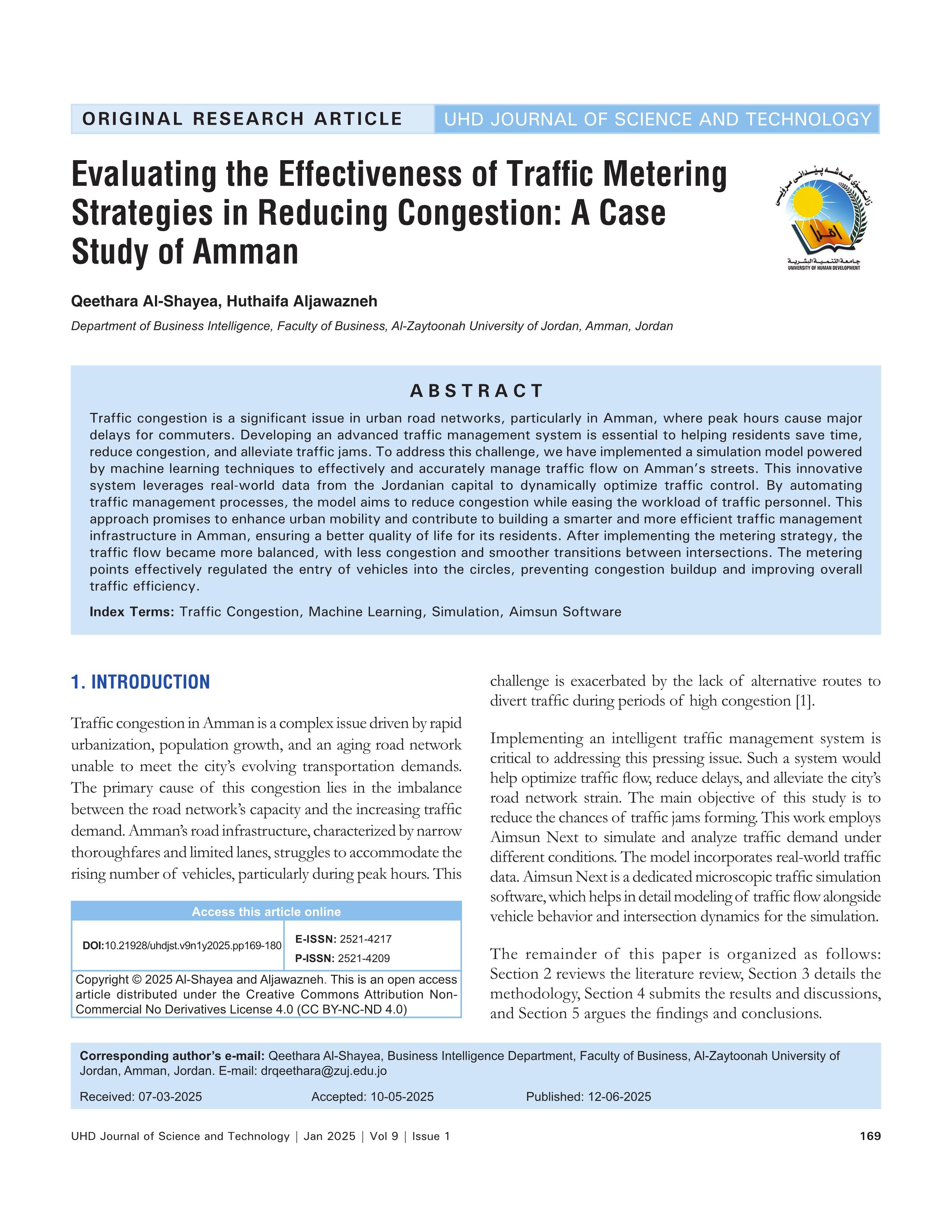Evaluating the Effectiveness of Traffic Metering Strategies in Reducing Congestion: A Case Study of Amman
DOI:
https://doi.org/10.21928/uhdjst.v9n1y2025.pp169-180Keywords:
Traffic Congestion, Machine Learning, Simulation, Aimsun SoftwareAbstract
Traffic congestion is a significant issue in urban road networks, particularly in Amman, where peak hours cause major delays for commuters. Developing an advanced traffic management system is essential to helping residents save time, reduce congestion, and alleviate traffic jams. To address this challenge, we have implemented a simulation model powered by machine learning techniques to effectively and accurately manage traffic flow on Amman's streets. This innovative system leverages real-world data from the Jordanian capital to dynamically optimize traffic control. By automating traffic management processes, the model aims to reduce congestion while easing the workload of traffic personnel. This approach promises to enhance urban mobility and contribute to building a smarter and more efficient traffic management infrastructure in Amman, ensuring a better quality of life for its residents. After implementing the metering strategy, the traffic flow became more balanced, with less congestion and smoother transitions between intersections. The metering points effectively regulated the entry of vehicles into the circles, preventing congestion buildup and improving overall traffic efficiency.
References
S. A. Naveed, U. Farooq, M. A. Raza, Z. U. Rehman, M. Saleem, and T. M. Ghazal. “Enhancing traffic flow and congestion management in smart cities utilizing SVM-based linear regression approach”. International Journal of Advanced and Applied Sciences, vol. 11, no. 10, pp. 166-175, 2024.
A. Boukerche, Y. Tao and P. Sun. “Artificial intelligence-based vehicular traffic flow prediction methods for supporting intelligent transportation systems. Computer Networks, vol. 182, p. 107484, 2020.
A. Arabiat, M. Hassan and Al Momani, O. “Traffic congestion prediction using machine learning: Amman city case study”. Proceedings of SPIE, vol. 13188, p. 1318806, 2024.
H. Jawarneh and M. Tawil. “Exploring the interrelation between traffic congestion and land uses in Amman: Challenges and potential”. Journal for Re-Attach Therapy and Developmental Diversities, vol. 6, no. 9s, pp. 962-978, 2023.
M. D. Laanaoui, M. Lachgar, H. Mohamed, H. Hrimech, S. G. Villar and I. Ashraf. “Enhancing urban traffic management through real-time anomaly detection and load balancing”. IEEE Access, vol. 12, pp. 63683-63698, 2024.
S. A. Salloum, T. Gaber, M. A. Almaiah, R. Shehab, R. Al-Ali and T. H. H. Aldahyani. “Adoption of a deep learning approach using realistic synthetic data for enhancing network intrusion detection in intelligent vehicle systems”. International Journal of Data and Network Science, vol. 9, no. 1, pp. 77-86, 2025.
R. Sathiyaraj, A. Bharathi, S. Khan, T. Kiren, I. U. Khan and M. Fayaz. “A genetic predictive model approach for smart traffic prediction and congestion avoidance for urban transportation”. Wireless Communications and Mobile Computing, vol. 2022, p. 5938411, 2022.
H. R. Al-Masaeid and N. J. Al-Omoush. “Trafc volume forecasting for rural roads in Jordan”. Jordan Journal of Civil Engineering, vol. 8, no. 3, pp. 319-331, 2014.
R. Qaddoura and M. Bani Younes. “Temporal prediction of traffic characteristics on real road scenarios in Amman”. Journal of Ambient Intelligence and Humanized Computing, vol. 14, no. 7, pp. 9751-9766, 2023.
M. M. Taamneh, A. H. Alomari and S. M. Taamneh. “Using machine learning to predict pedestrian compliance at crosswalks in Jordan”. Applied Sciences, vol. 14, no. 11, p. 4945, 2024.
R. Al Shafie, K. H. Jadaan, S. H. El-Badawy, S. Shwaly and U. Shahdah. “Exploring the utility of auto-machine learning in predicting traffic accident severity in Jordan”. Jordan Journal of Civil Engineering, vol. 18, no. 4, pp. 583-594, 2024.
Aimsun Next User Manual. “Aimsun Next Simulation Software”. 2023. Available from: https://www.aimsun.com/aimsun-next-downloads [Last accessed on 2025 Feb 03].
H. R. Al-Masaeid and T. I. Al-Suleiman. “Traffic flow analysis in Urban areas: A case study of Amman, Jordan”. International Journal of Civil Engineering, vol. 19, no. 4, pp. 567-578, 2021.
B. S. Kerner. “The Physics of Traffic: Empirical Freeway Pattern Features, Engineering Applications, and Theory”. Springer, Berlin, Germany, 2024.
J. Barceló. “Fundamentals of Traffic Simulation”. Springer, Berlin, Germany, 2010.
C. F. Daganzo. “Fundamentals of Transportation and Traffic Operations”. Pergamon, United Kingdom, 1997.
E. Brockfeld, R. D. Kühne and P. Wagner. “Calibration and validation of microscopic traffic flow models”. Transportation Research Record: Journal of the Transportation Research Board, vol. 1876, pp. 62-70, 2004.
M. Treiber and A. Kesting. “Traffic Flow Dynamics: Data, Models and Simulation”. Springer, Berlin, Germany, 2013.
R. W. Rothery. “Car Following Models, Traffic Flow Theory”. Transportation Research Board, Washington, DC, 1992.
T. V. Mathew. “Transportation Systems Engineering”. IIT Bombay, 2014. Available from: https://www.transportation_engg_-_tom_v_ mathew.pdf [Last accessed on 2025 Mar 01].

Downloads
Published
How to Cite
Issue
Section
License
Copyright (c) 2025 Qeethara Al-Shayea, Huthaifa Aljawazneh

This work is licensed under a Creative Commons Attribution-NonCommercial-NoDerivatives 4.0 International License.


